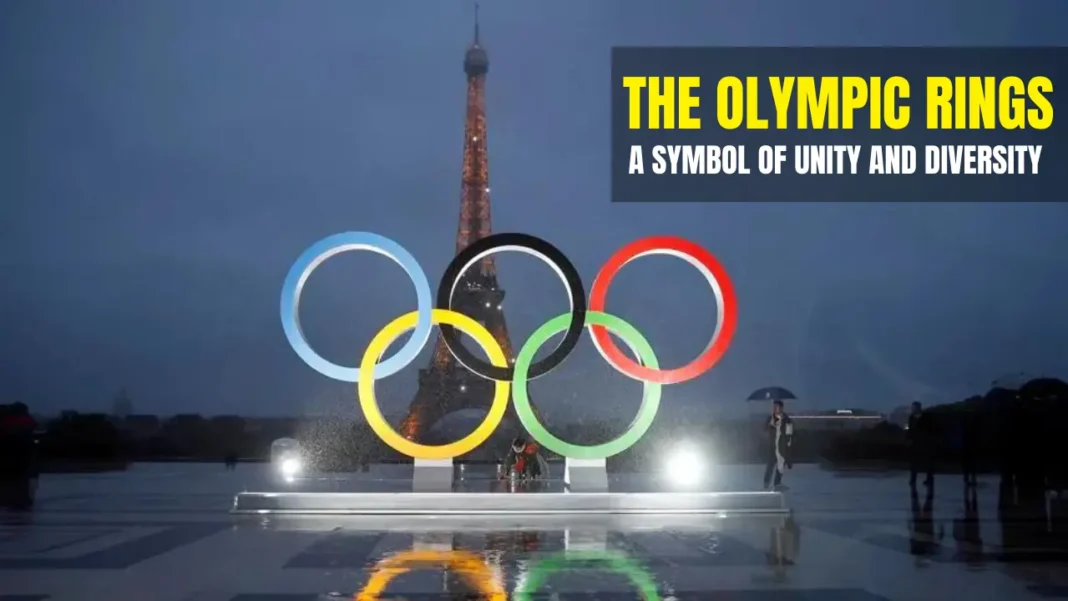Introduction Olympic Rings
The Olympic rings are one of the most recognizable symbols in the world. Representing the ideals of the Olympic Games and the coming together of athletes from all corners of the globe, the rings hold significant historical and cultural importance. This article delves into the history, meaning, and impact of the Olympic rings, providing a comprehensive overview of this iconic symbol.
Origins of the Olympic Rings
The concept of the Olympic rings was introduced by Pierre de Coubertin, the founder of the modern Olympic Games. Inspired by ancient Greek traditions and the idea of bringing nations together through sport, de Coubertin sought a symbol that would encapsulate the unity and diversity of the Olympic Movement.
Introduction by Pierre de Coubertin
In 1913, Pierre de Coubertin proposed the design of the rings of Olympic , featuring five interlocking rings in different colors. He envisioned the rings as a universal symbol that would represent the coming together of athletes from all over the world.
Early Designs and Evolutions
The initial design of the rings of Olympic featured five interlocking rings colored blue, yellow, black, green, and red on a white background. Over the years, the design has undergone minor changes, but the fundamental elements have remained consistent.
Adoption by the International Olympic Committee (IOC)
The IOC officially adopted the rings of Olympic as the symbol of the Olympic Movement in 1914. Since then, the rings have been prominently featured in Olympic branding, ceremonies, and promotional materials.
Historical Milestones and Changes
Throughout the history of the Olympics, the rings have played a central role in various milestones and changes. From the first appearance at the 1920 Antwerp Games to their inclusion in digital and virtual platforms, the rings have continuously evolved to stay relevant.
The Five Rings and Their Colors
Each of the five rings in the Olympic symbol represents one of the inhabited continents of the world: Africa, the Americas, Asia, Europe, and Oceania. The colors – blue, yellow, black, green, and red – were chosen because at least one of these colors appears on the flag of every nation.
Representation of the Five Continents
The interlocking rings symbolize the meeting of athletes from around the world at the Olympic Games. They represent the unity of the five continents and the athletes who compete on the world stage.
Symbol of Unity and Peace
The Olympic rings are more than just a symbol of athletic competition; they are a symbol of peace and unity. The Olympics aim to foster international cooperation and understanding through sport.
Evolution of Symbolism Over Time
Over the years, the symbolism of the rings of Olympic has evolved to reflect contemporary values and global issues. Today, they are seen as a symbol of sustainability, diversity, and inclusion.
Design Principles of the Olympic Rings
The design of the rings in Olympic adheres to several key principles, including simplicity, universality, and versatility. The rings are designed to be easily recognizable and adaptable to various contexts and media.
Color Selection and Significance
The colors of the rings on Olympic were selected to ensure that at least one of them appears on every national flag in the world. This choice emphasizes the global nature of the Olympics and the inclusion of all nations.
Integration into Olympic Branding
The rings in Olympic are a central element of Olympic branding. They are used in logos, promotional materials, and merchandise, helping to create a cohesive and recognizable brand identity.
Variations and Adaptations
While the core design of the Olympic ring remains unchanged, there have been numerous variations and adaptations over the years. These include stylized versions, digital animations, and thematic adaptations for specific Olympic Games.
Influence on International Sporting Events
The Olympic ring have influenced the branding and symbolism of many other international sporting events. Their success has set a standard for how sports organizations represent unity and competition.
Cultural Representation and Unity
The rings serve as a powerful symbol of cultural representation and unity. They highlight the diversity of the Olympic community and promote a sense of global togetherness.
The Rings in Popular Culture
The Olympic rings have permeated popular culture, appearing in movies, television shows, and advertising. Their iconic status makes them a powerful tool for storytelling and marketing.
Use in Education and Awareness Programs
Educational programs often use the Olympic ring to teach values such as teamwork, perseverance, and international understanding. They serve as a visual aid for lessons on the importance of sportsmanship and global cooperation.
Olympic Rings in Modern Times
Contemporary Uses and Adaptations
In the modern era, the Olympic rings have been adapted for use in various digital and multimedia platforms. They are featured in virtual reality experiences, mobile apps, and social media campaigns.
Digital Era and Branding
The digital era has brought new opportunities for Olympic branding. The rings are now part of interactive experiences and online content, reaching a broader and more diverse audience.
Merchandise and Commercial Use
The Olympic ring are prominently featured on a wide range of merchandise, from clothing to souvenirs. This commercial use helps to generate revenue for the Olympic Movement and promote the Games.
The Rings in Social Media
Social media platforms have become a crucial tool for promoting the Olympic ring and engaging with fans. Hashtags, filters, and digital campaigns leverage the rings to create buzz and excitement around the Olympics.
Misuse and Misrepresentation
The Olympic rings have occasionally been misused or misrepresented, leading to legal and ethical challenges. Unauthorized use of the symbol can undermine its integrity and dilute its meaning.
Legal Issues and Trademark Protection
The IOC has strict guidelines and protections in place to prevent unauthorized use of the Olympic ring. Trademark protection is essential to maintain the symbol’s exclusivity and value.
Cultural Sensitivities and Criticisms
Despite their universal appeal, the Olympic ring have faced criticisms and cultural sensitivities. Some argue that the symbol does not fully represent the diversity and complexities of the global community.
The Role of the IOC in Addressing Challenges
The IOC plays a crucial role in addressing challenges related to the Olympic ring. This includes enforcing trademark protections, addressing cultural criticisms, and ensuring the symbol remains relevant and respected.
Successful Integrations of the Rings in Olympic Games
Various Olympic Games have successfully integrated the rings into their branding and ceremonies. Notable examples include the Sydney 2000 Games and the London 2012 Games, where the rings were prominently featured in innovative ways.
Missteps and Lessons Learned
There have been instances where the use of the Olympic ring has not been well-received. These missteps provide valuable lessons for future branding and marketing efforts.
Innovations in Branding and Presentation
The Olympic Movement continues to innovate in how it presents the rings. From augmented reality to immersive experiences, new technologies are enhancing the way the rings are showcased.
The Future of the Olympic Rings
The future of the Olympic rings is likely to involve further innovations and adaptations. As the world evolves, so too will the ways in which the rings are used and represented.
Potential Changes and Innovations
Potential changes to the Olympic ring could include new digital integrations, thematic adaptations, and increased emphasis on sustainability and inclusivity.
The Rings as a Symbol of Global Unity
As global challenges continue to arise, the Olympic ring will remain a powerful symbol of unity and resilience. They will continue to inspire and bring people together through the spirit of sport.
Predictions for Future Games
Future Olympic Games will likely feature even more creative and innovative uses of the rings. From digital platforms to new forms of media, the rings will continue to evolve and captivate audiences worldwide.
Interviews with Olympic Historians
Olympic historians provide valuable insights into the history and significance of the rings. Their perspectives shed light on the enduring legacy of this iconic symbol.
Perspectives from Designers and Branding Experts
Designers and branding experts offer unique viewpoints on the design and use of the Olympic ring. Their expertise highlights the importance of maintaining a strong and cohesive brand identity.
Insights from Athletes and Coaches
Athletes and coaches share their experiences and thoughts on the Olympic ring. Their stories underscore the emotional and inspirational power of the symbol.
Conclusion
The Olympic rings are a powerful symbol of unity, diversity, and excellence. They represent the ideals of the Olympic Movement and the coming together of athletes from all over the world.
The Enduring Legacy of the Olympic Rings
The rings will continue to inspire and unite people through sports, fostering a sense of global togetherness and cooperation. Their legacy endures as a testament to the power of sport to bring people together across continents and cultures.




